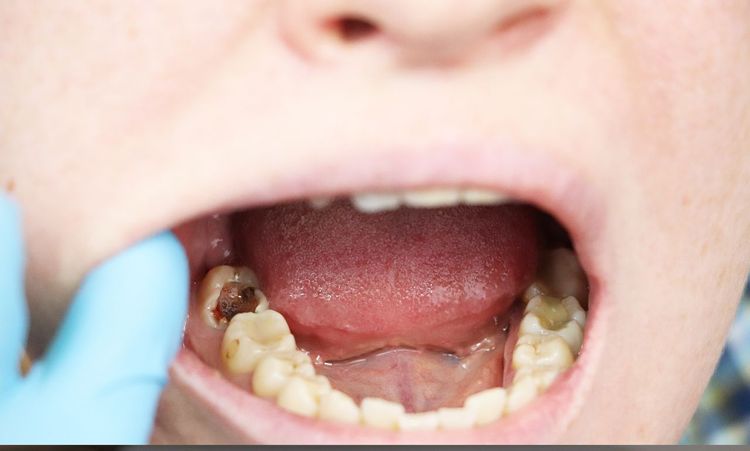You diligently brush twice a day, floss religiously, and maybe even sport a gleaming white smile. Yet, a nagging sensitivity while biting down on an apple or a faint ache when you sip your morning coffee whispers of a hidden enemy: interproximal cavities. These stealthy foes lurk in the tight spaces between your teeth, often invisible to the naked eye, silently eroding your dental health.
Understanding how dentists tackle these elusive cavities empowers you to take charge of your oral well-being. So, let's delve into the world of interproximal cavities, exploring their causes, recognizing their subtle cues, and uncovering the treatment options available to restore your smile's strength and brilliance.
Causes of Interproximal Cavities
While a straightforward concept, the formation of cavities, particularly those nestled between your teeth, involves a complex interplay of factors. Let's break down the key culprits contributing to this dental dilemma:
1. Poor Oral Hygiene

Imagine your mouth as a bustling metropolis. Every time you consume food, especially sugary treats and starchy snacks, microscopic bacteria residing in your mouth throw a feast. These bacteria, in turn, produce acids as byproducts of their sugary indulgence. Now, if you neglect your oral hygiene routine, these acids linger on your teeth, gradually eroding the enamel – the protective outer layer of your teeth – and paving the way for cavities.
Think of it like this: brushing and flossing are akin to sending in a cleaning crew to tidy up after the bacterial feast. Without this regular maintenance, the acidic remnants wreak havoc, particularly in the tight, often-missed spaces between your teeth, creating prime real estate for interproximal cavities to flourish.
2. Plaque Buildup
Plaque, a sticky film teeming with bacteria, constantly forms on your teeth. When you consume sugary or starchy foods, the bacteria in plaque produce acids that attack your enamel. If not removed through regular brushing and flossing, plaque hardens into tartar, a stubborn deposit that requires professional cleaning.
The problem intensifies in the interdental spaces. These tight spots offer plaque an undisturbed haven to accumulate and harden, making the enamel in these areas particularly susceptible to decay, ultimately leading to how do they fill cavities in between teeth, a question many face due to this insidious buildup.
3. Dietary Choices
Your diet plays a pivotal role in your oral health, directly influencing the environment in your mouth. Frequent consumption of sugary drinks and snacks provides a constant supply of fuel for cavity-causing bacteria. The bacteria feast on these sugars, producing acids that attack your teeth.
Furthermore, foods that cling to your teeth, like sticky candies or chewy bread, provide a prolonged opportunity for acid production, increasing the risk of cavities, particularly in those hard-to-reach interdental spaces.
Treatment Options
Discovering you have an interproximal cavity might seem daunting, but rest assured, various treatment options are available to address the issue and restore your oral health. The specific approach your dentist recommends depends on the extent of the decay and your individual needs.
1. Remineralization
In the very early stages of decay, when the enamel has just begun to demineralize, your dentist might recommend remineralization. This non-invasive approach aims to strengthen the weakened enamel and potentially reverse the decay process.
Remineralization typically involves applying fluoride varnishes or using prescription-strength fluoride toothpaste. Fluoride helps attract minerals like calcium and phosphate, which are naturally present in your saliva, to the tooth surface, promoting remineralization and strengthening the enamel.
2. Dental Fillings
For more advanced cavities, where the decay has progressed beyond the initial stages of enamel erosion, dental fillings are the most common treatment option. This procedure involves removing the decayed portion of the tooth and filling the resulting cavity with a tooth-colored composite resin or other dental materials.
How do they fill cavities in between teeth, you ask? Due to the tight spaces, accessing and filling interproximal cavities can be slightly more intricate. Your dentist might use specialized instruments, such as dental wedges or matrices, to create separation between the teeth, allowing for proper access and restoration of the cavity.
3. Root Canals
If the decay reaches the pulp, the innermost part of the tooth containing nerves and blood vessels, a root canal might be necessary. This procedure involves removing the infected or damaged pulp, cleaning and disinfecting the root canals, and then filling and sealing the space to prevent further infection.
While often associated with a sense of dread, root canals are designed to save a severely damaged tooth from extraction. With modern techniques and anesthesia, the procedure is typically no more uncomfortable than getting a filling.
4. Crowns
In cases of extensive decay or if the tooth has become weakened due to a large filling, your dentist might recommend a crown. A crown is a custom-made, tooth-shaped cap that covers the entire visible portion of the tooth, providing strength, protection, and restoring its natural shape and appearance.
Crowns are typically made from porcelain, ceramic, or metal alloys, and are designed to withstand biting forces, ensuring the restored tooth functions properly.
The Filling Procedure
Understanding the process of getting a filling, particularly for an interproximal cavity, can help alleviate any anxiety and prepare you for the experience. Here's a breakdown of the typical steps involved:
1. Cavity Assessment
The first step involves a thorough examination of your teeth, often aided by dental X-rays. These X-rays provide a clear picture of the extent of the decay, allowing your dentist to assess the cavity's size, location, and proximity to the nerve. Based on this assessment, your dentist will recommend the most appropriate filling material and treatment plan.
2. Decay Removal
Once the assessment is complete, the next step involves removing the decayed portion of the tooth. Your dentist will use a high-speed dental drill or a laser to gently and precisely remove the decay, creating a clean cavity for the filling material.
3. Filling Material Application

With the decay removed, your dentist will prepare the tooth for the filling material. This might involve applying an etching solution to create a rough surface for better adhesion. Then, the chosen filling material, typically a tooth-colored composite resin, is applied in layers, each layer hardened using a special light.
4. Post-Filling Care
After the filling is complete, your dentist will polish and shape it to ensure a proper bite and a natural feel. You might experience some temporary sensitivity to hot or cold temperatures after the procedure, but this usually subsides within a few days.
Maintaining good oral hygiene is crucial after getting a filling. Continue brushing twice a day, flossing daily, and visiting your dentist for regular checkups and cleanings to prevent future cavities and keep your restored smile healthy and vibrant.
Conclusion
Interproximal cavities, though often hidden from plain sight, can significantly impact your oral health if left untreated. By understanding their causes, recognizing the subtle warning signs, and being proactive with your oral hygiene, you can prevent these stealthy foes from taking hold.
Remember, regular dental checkups are your greatest ally in the fight against cavities. Your dentist can detect and address these issues early on, preventing further damage and preserving the integrity of your smile. By partnering with your dental professional and embracing a proactive approach to oral health, you can conquer those hidden cavities and enjoy a lifetime of confident, radiant smiles.




